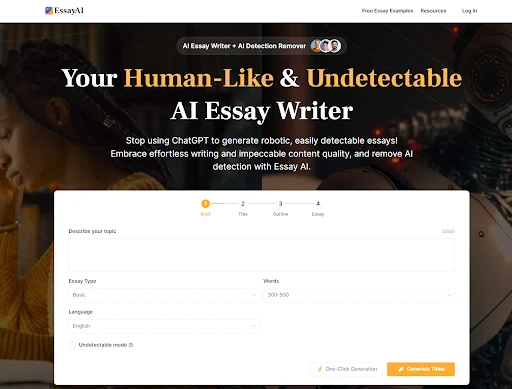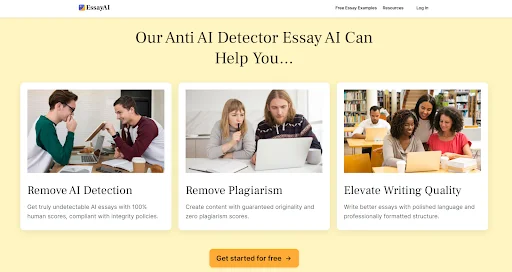In the digital age, academia and technology converge more dramatically than ever before, introducing tools that both challenge and advance the integrity of education. Among these innovations, EssayAI represents a significant leap, positioning itself as a frontrunner in the sphere of AI-supported educational tools.
This review delves into the multifaceted capabilities of EssayAI, dissecting how it stands as an undetectable AI essay writer, a human-like AI essay writer, and more importantly, how it purports to bypass AI detectors effectively. With a balanced examination, we aim to uncover whether EssayAI delivers on its promises without veering into the realms of academic dishonesty.

The Core of EssayAI: More Than an Essay Generator
Bypassing AI Detectors: A Closer Look
The aspiration to bypass AI detectors is, without doubt, a contentious cornerstone of EssayAI’s offering. With academic institutions increasingly deploying sophisticated tools to identify AI-generated content, the demand for undetectable AI essay writers has surged. EssayAI responds to this demand with a robust model trained on an expansive corpus of over 100 million professionally written essays. This not only imbues it with an impressive grasp of varied subjects but positions it as a tool capable of producing work that evades the scrutiny of AI detection.
Human-Like AI Essay Writer: Blurring Lines Between Human and AI Capabilities
EssayAI’s claim to fame is its ability to remove AI detection markers from its outputs, essentially making essays appear as if crafted by human hands. This involves nuanced language use, contextual understanding, and the avoidance of repetitive, detectable patterns often associated with AI-generated content. The platform’s underlying technology aims to understand and mimic human cognitive processes in essay writing, striving for a balance between technical acumen and the artful nuance of human expression.
The Integrity Question: Removing AI Detection
In advocating for an undetectable AI essay writer, EssayAI opens up a Pandora’s box of ethical considerations. The functionality to remove AI detection is doubled-edged; while it can serve legitimate purposes such as aiding in drafting and idea generation, it equally paves the way for misuse within academic settings. This feature, while technologically impressive, thus requires a careful examination of the moral implications surrounding its use, highlighting the platform’s responsibility in guiding users towards integrity-filled practices.
Informative Articles
EssayAI presents a thorough array of articles dedicated to essay writing, featuring in-depth insights and practical tips designed to advance your writing proficiency. If you’re encountering issues with making an essay longer, they have you covered.
The EssayAI Experience: From Idea to Submission

Crafting Tailored Essays Across Disciplines
The platform’s versatility allows users to generate content that spans various types and levels of academic inquiry. Whether it’s a high school paper on literature or a college-level case study in sociology, EssayAI asserts its capability to deliver tailored content. This adaptability extends to addressing the unique needs of ESL students, part-time learners, and even content writers seeking to enrich their work with authoritative, insightful essays.
Elevating Writing Quality: Beyond the Basics
Beyond generating undetectable content, EssayAI emphasizes its role in elevating essay quality. Through smart outlining and structuring, coupled with a keen understanding of essay prompts, it purports to assist users in organizing their thoughts coherently. This aligns with the broader educational goal of enhancing students’ critical thinking and writing skills, albeit through the lens of AI assistance.
Plagiarism-Free Content Generation
A pillar of EssayAI’s promise is its assurance of generating plagiarism-free content. In an academic landscape where the authenticity of ideas and expressions is paramount, this feature stands out. The platform’s built-in mechanisms for ensuring originality not only cater to academic standards but also reinforce the value of creating unique, insightful essays devoid of any unattributed content.
Conclusion: The Dual Edges of Innovation
EssayAI embodies the cutting-edge of educational technology, offering tools that can both enhance and complicate the academic endeavor. Its ability to produce human-like, undetectable essays that can bypass AI detectors speaks to a significant technological achievement. However, this review recognizes the inherent risks associated with such capabilities, underscoring the necessity for ethical guidelines and responsible use.
In sum, EssayAI presents a potent tool for those navigating the complexities of academic writing in the digital age. Whether it becomes a vehicle for educational empowerment or ethical dilemmas will largely depend on the choices of its users and the policies of educational institutions. As with any tool, the value of EssayAI lies not just in its technical capabilities but in how it is applied within the broader context of learning and intellectual growth.





